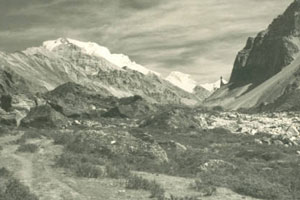1952 Sikkim/Nepal Expedition
The objective of my father’s 1952 expedition was to trek into the eastern part of Sikkim. In this he followed some of the same initial route of the 1949/1950 expedition undertaken with Trevor Braham. In late October he flew from Calcutta to Bagdogra and after an overnight stay in Darjeeling, left the next day by car for Gangtok. Here he was met by his expedition team of six sherpas and two sherpanis (photograph #10). They finalised all their provisioning needs and hired mountain ponies to carry their provisions and tents part of the way to Singhik, where they parted with the pony escort.
Their route followed the Teesta River (photograph #7) to Dikchu, onto to Mangan and Singhik. From Singhik they trekked to Changtang via Tong. At Changtang, the rivers Lachen Chu and Lachung Chu converge. They took the right fork in the river towards Kedom and Lachung, finally arriving in Lachung five days later. At Lachung they again overnighted at the chowkidar’s Dak bungalow (photograph #8).

View north of Lachung Valley
From Lachung they trekked along the Lachung Chu (photographs #11,19,21,22) in a beautiful valley to Yumthang (photographs #23,24,25,26,27,28) and then on to Mome Samdong (photographs #29,30). On August 15th there had been the great Tibet – Assam earthquake which also affected this region. The Sebu Cho (lake) is fed by the icefall on the lower portion of Chombu mountain 6363m. During the earthquake, a large portion of this icefall is believed to have collapsed, sending large chunks of ice into the Sebo Cho causing the lake to burst. The released waters from the lake became like a tidal wave and swept everything before them and this caused severe damage down the valley, in the process destroying half of Lachung village and sweeping away many suspension bridges that crossed the Lachung Chu. The route from Lachung to Mome Samdong was now mainly over boulders and moraine debris (photograph #14). They camped near Mome Sandong at a site with a few scattered small lakes and scrub and juniper wood which could be burnt for cooking and also provide a healthy campfire for warmth. On this section of the route they had a magnificent view of Mt. Shariki Danenchung 5557m (photograph #20).
Near Mome Samdong they had a good view of Mt. Pauhunri 7125m (photograph #31) and a view of the south face of Mt. Chombu 6363m (photograph #24,32,33,38,46). From Mome Sandong they climbed to the Sebu La pass 5352m (photographs #36,37,39,40,41,42,43,44,45) where they had a close-up view of Mt. Kanchenjau 6919m (photograph #34,35,36,39) and a view of Mt. Yulhekang 6429m (photograph #35). After crossing the Sebu La pass they established a camp on the western side of the pass where they got a splendid view of Mt. Gordamah Peak (now known as Gurudonmar Peak) 6715m (photograph #40). From here there was a splendid view across the valley of Mt. Kangchenjunga 8585m (photograph #42,43,44) to the southwest and sweeping to the right they could see Jongsong Peak 7459m (photograph #42).
They proceeded to Lugnak La pass 5035m and made their way into the Lhonak Valley (photograph #47,48,49,50,) via Lugnak La pass 5035m to Muguthang 4520m and Dolimasampa . As they proceeded down the valley they could see to the west Langpo Peak 6955m (photograph #51,55,56,66) and Langchung Kang 6759m (photograph #51,57).

View of Drohmo Peak 6850m with Pyramid Peak 7123m in the centre
From here they trekked into the Langpo Chu valley and they set up a camp in the close vicinity of Langpo Peak 7462m. From here they could see to the northwest Jongsong Peak 7462m (photograph #52,53) and to the northeast the impressive Fluted Peak 7462m (photograph #54). Further afield to the northwest they could see Dodang Nyima Peak 6927m (photograph #58,64) and Kohayedu Peak (photograph #59). To the northeast they could see the numerous peaks in the Chomiono mountain range (photograph #62).
They then moved into the Jongsong Glacier (photograph #65,66) and the Langchung Khang Glacier area. In the distance they could see the Dodang Nyima mountain range to the north. From here the expedition proceeded to the Jongsong La pass at 6145m (photograph #67,68,69) where they enjoyed again superlative views of both Langpo Peak 6955m, and Langchung Kang Peak 6759m (photograph #70).
From here the expedition moved down into the valley to the western spur of Langchung Kang 6759m. To the south the eastern flank of Pyramid Peak 7123m (photograph #71,72) and further south beyond Pyramid Peak they could see the magnificent Kangchenjunga 8586m (photograph #73,75). The expedition moved further down into the valley. From here the expedition skirted the northern side of the Kangchenjunga glacier on its way to Lhonak.
On this stretch of the route they had magnificent views of Kangchenjunga 8586m (photograph #78,79) with two of its five terraces visible. To the south from Lhonak, Jannu Peak 7710m (photograph #73) could be seen. Jannu (now officially known as Kumbhakarna) lies 11km to the West of the summit of Kangchenjunga. Also visible from this part of the route are parts of the Twins Glacier (photograph #76) and The Twins peaks (photograph #77).
Between Lhonak and Ramtang they passed the Ramtang glacier and to the east they could see Wedge Peak (now known as Chang Himal) 6750m (photograph #80) with the Kangchenjunga glacier (photograph #80) in the foreground. To the north they has superb views of Drohmo Peak 6850m (photograph #81) with Pyramid Peak 7123m (photograph #81) in the distance.
From here the expedition passed through Khambachen to Ghunsa via Mirgin La to Tseram to Dzongri and from here on to Darjeeling where the members of this expedition disbanded and my father made his way back to Calcutta.
